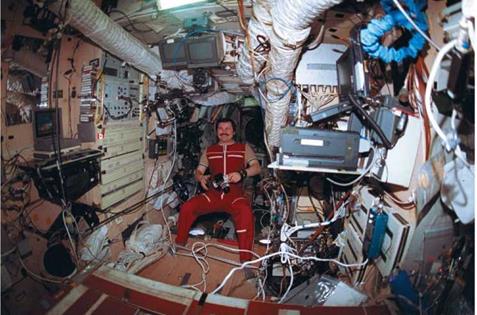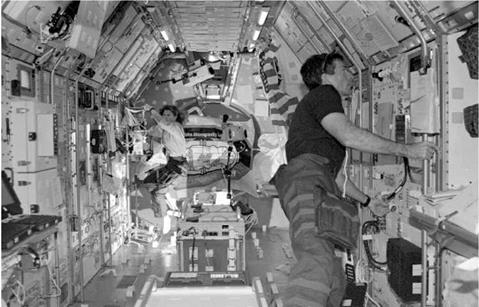A difficult third decade
The 1980s were termed the reality years for good reason, for both the Soviets and Americans. The Soviets, despite great success with their Salyut and Mir programs,
|
Inside a clutter—Mir during the 1990s. |
were suffering from lack of funding to expand the program as planned. An improved station, Mir 2, was struggling for funding even to be built; Buran had flown successfully, proving the concept, but was also unable to attract funds to continue. On top of all this, the country itself was under extreme pressure both internally and externally to change and reform. The surprising and sudden demise of communism towards the end of the decade in Eastern Europe—and the eventual breakup of the U. S.S. R.—was a major catalyst with global repercussions, and the pride of Soviet achievement—the Soviet space program—suffered. If it was to survive, the program would have to find other avenues of funding, much to the frustration of the older leadership in the design bureaus, the corridors of the Kremlin, and the top brass in the military. For a while, the program struggled on, but talks were in hand to help restore its pride and ensure its survival through the final decade of the century and beyond.
For NASA, the Shuttle was not delivering what was promised. The launch costs could not be lowered and the USAF had backed out of ordering their own orbiters and operating them from California. Commercial applications that took advantage of the unique characteristics of both the microgravity environment and the Shuttle transportation system were few and far between. It was becoming harder to keep the Shuttle flying and far from routine to launch them on time. The Challenger accident remained a painful memory.
On the positive side, as well as some remarkable flight operations once the vehicle attained orbit, significant lessons were learned and experience gained from
|
Working inside the Spacelab science module during a Shuttle mission. |
repeated ground turnaround, from planning to processing, launching, and recovery to postflight analysis of the fleet of vehicles. A similar learning curve came from flying the dozens of payloads and experiments that the fleet did carry, from the smallest school experiment to complex Spacelab payloads.
Hovering in the background of all this was the Freedom space station program, which was slowly gaining momentum following its 1984 authorization. Unfortunately, it was also gaining in size, mass, complexity, and cost. The new decade would once again signal changes, both on Earth and for operations in its orbit.












